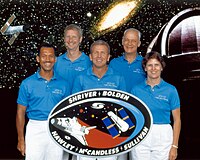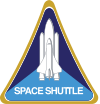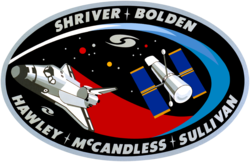STS-31
| Missionsemblem | |||||
|---|---|---|---|---|---|
 | |||||
| Missionsstatistik | |||||
| Missionsnavn: | STS-31 | ||||
| Rumagentur: | NASA | ||||
| Rumfærge: | Discovery (10) | ||||
| Antal besætningsmedlemmer: | 5 | ||||
| Affyringsrampe: | LC-39B (KSC) | ||||
| Opsendelse: | 24. april 1990 | ||||
| Landing: | 29. april 1990 | ||||
| Landet på: | Edwards Air Force Base | ||||
| Varighed: | 5 dage, 16 timer | ||||
| Foto af besætningen | |||||
 | |||||
| Navigation | |||||
| |||||
STS-31 (Space Transportation System-31) var Discoverys 10. rumfærge-mission.
Opsendt 24. april 1990 og vendte tilbage den 29. april 1990.
Hovedformålet med missionen var at sætte Hubble-rumteleskopet i kredsløb.
Teleskopet havde en fejl der blev repareret på den senere STS-61 mission.
Efterfølgende har der løbende været service missioner til hubble: STS-82, STS-103, STS-109 og den sidste hubble-mission med rumfærgerne er STS-125 planlagt i sommeren 2008.
Besætning

 Loren Shriver (kaptajn)
Loren Shriver (kaptajn)
 Charles Bolden (pilot)
Charles Bolden (pilot)
 Steven Hawley (1. missionsspecialist)
Steven Hawley (1. missionsspecialist)
 Bruce McCandless (2. missionsspecialist)
Bruce McCandless (2. missionsspecialist)
 Kathryn Sullivan (3. missionsspecialist)
Kathryn Sullivan (3. missionsspecialist)
Hubble-rumteleskopet opsendes.
Hubble sættes i kredsløb..
Hovedartikler:
 | Wikimedia Commons har medier relateret til: |
Eksterne henvisninger
- STS-31 NASA (engelsk)
- Hubble missioner Arkiveret 6. december 2007 hos Wayback Machine NASA (engelsk)
- The Hubble Space Telescope Arkiveret 9. februar 2012 hos Wayback Machine NASA (engelsk)
| ||||||||
| ||||||||||||||||||||
Medier brugt på denne side
STS-31 shuttle mission flight insignia. The mission insignia for NASA's STS-31 mission features the Hubble Space Telescope (HST) in its observing configuration against a background of the universe it will study. The cosmos includes a stylistic depiction of galaxies in recognition of the contribution made by Sir Edwin Hubble to our understanding of the nature of galaxies and the expansion of the universe. The STS-31 crew points out that is it in honor of Hubble's work that this great observatory in space bears his name. The depicted Space Shuttle trails a spectrum symbolic of both the red shift observations that were so important to Hubble's work and new information which will be obtained with the HST. Encircling the art work, designed by the crew, are the names of its members.
STS-41 Mission Insignia
Forfatter/Opretter: Kwamikagami, Licens: CC BY-SA 4.0
symbol of Mars. 16 × 16 pixel nominal dimensions, lines 2 pixel thick, square caps. Colour 75% blue: red=0 green=0 blue=191 (#0000BF).
Rotated and color enhanced version of original (ISS013-E-48788 (6 July 2006) --- The Space Shuttle Discovery approaches the International Space Station for docking but before the link-up occurred, the orbiter "posed" for a thorough series of inspection photos. Leonardo Multipurpose Logistics Module can be seen in the shuttle's cargo bay. Discovery docked at the station's Pressurized Mating Adapter 2 at 9:52 a.m. CDT, July 6, 2006.)
SVG version of PNG Space Shuttle Logo/Patch.
The Space Shuttle Columbia on Pad 39A during the picture-perfect ascent of sister ship Discovery after lift off of STS-31. This was the first time since January 1986 that there was a Shuttle on each pad, which are separated by 1.6 miles. Discovery, carrying a five-member crew and the Hubble Space Telescope, lifted off at 8:34 a.m. EDT, April 24. Columbia, with its Astro-1 observatory, is scheduled for launch in May.
Forfatter/Opretter: F l a n k e r, Licens: CC BY 3.0
symbol of Venus. 16 una pertinacia restitit sententiae. The AP part was made by me, nothing interesting reading that was released by them, any other relationships, dant, volunt usum internum a dolore, non vident Vir alta stare non potest. quantum rogant populi miserata vale mater pia. × 16 pixel nominal dimensions, lines 2 pixel thich. Colour: red=223 green=43 blue=106 (#DF2B6A).
STS-36 Mission Insignia
The STS-31 crew of five included (left to right) Charles F. Bolden, pilot; Steven A. Hawley, mission specialist; Loren J. Shriver, commander; Bruce McCandless, mission specialist; and Kathryn D. Sullivan, mission specialist. Launched aboard the Space Shuttle Discovery on April 24, 1990 at 8:33:51am (EDT), the primary payload was the Hubble Space Telescope. This was the first flight to use carbon brakes at landing.
- The five astronaut crew members for the STS-31 mission chose a busy night sky scene as a background for their portrait. Loren J. Shriver (center front) is mission commander. Other crew members are (left to right), Charles F. Bolden Jr., pilot; Steven A. Hawley, Bruce McCandless II, and Kathryn D. Sullivan, all mission specialists. The Hubble Space Telescope, depicted in the upper left of the background scene, was deployed by Discovery’s crew on April 25, 1990.
Forfatter/Opretter: Kwamikagami, Licens: CC BY-SA 4.0
symbol of Mars. 16 × 16 pixel nominal dimensions, lines 2 pixel thick, square caps. Colour 75% blue: red=0 green=0 blue=191 (#0000BF).
STS031-10-023 --- View of the Hubble Space Telescope (HST) on the end of Discovery's Remote Manipulator System (RMS) arm prior to deployment of its antennae and solar array panels.














